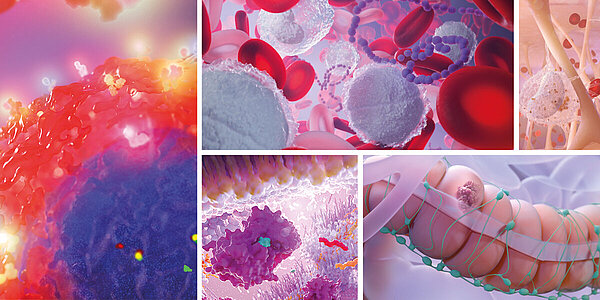Scientific Calendar July 2024
What changes in VWF levels can be found in patients in the acute phase of an underlying chronic disease?
What changes in VWF levels can be found in patients in the acute phase of an underlying chronic liver disease?
No changes.
Decreased VWF:AG levels and activity.
Significant increased VWF:AG levels and activity
Congratulations!
That's the correct answer!
Sorry! That´s not completely correct!
Please try again
Sorry! That's not the correct answer!
Please try again
Notice
Please select at least one answer
Scientific background
Von Willebrand factor and ADAMTS13
Von Willebrand factor (VWF) is a glycoprotein mediating platelet adhesion and protects factor VIII from early proteolysis. VWF is synthesised and excreted by endothelial cells and megakaryocytes. It circulates in the blood as a complex with factor VIII, thereby protecting it from proteolysis. VWF binds to the proteins of the subendothelial matrix, as well as to the von Willebrand receptor (glycoprotein Ib/IX) on the surface of platelets. Through this process, it establishes a bond between platelets and the injured vessel wall, resulting in platelet activation. [1]
VWF belongs to the group of acute phase proteins and is present in plasma as a multimer whose length is regulated by the following: a special protease, a disintegrin and metalloproteinase with a thrombospondin type 1 motif, member 13 (ADAMTS13). Proteolysis of VWF by ADAMTS13 reduces the size of plasma VWF to a series of multimers with limited functional activity. [1] ADAMTS13 is expressed and secreted by hepatic stellate cells and endothelial cells. [2, 3, 4] Severe systemic inflammation is often associated with endothelial and liver dysfunction, often leading to a reduction in ADAMTS13 activity. [5, 6] Inflammatory processes increase the concentrations of the cytokine interleukin-6 (IL-6) and the serine protease thrombin, resulting in an enhanced proteolysis of ADAMTS13 in the blood [8, 9, 10]. As observed in thrombotic thrombocytopenic purpura (TTP) a severe deficiency of ADAMTS13 causes an elevation of circulating large VWF multimers, which triggers thrombotic microangiopathy (TMA). [11, 12, 13]
VWF and ADAMT13 in patients with organ failure
Elevated vWF antigen levels (VWF:AG) as an expression of endothelial dysfunction significantly influence the course of the disease. [14] Even strenuous physical exercise can lead to an increase in VWF:AG immediately afterwards, with a simultaneous drop in ADAMTS13 values. However, these values usually return to the initial levels within a few hours without any clinically relevant consequences. Due to its biological function as an acute phase protein, elevated VWF:AG levels are also found following surgery. Studies have shown that this increase is usually moderate in uncomplicated cases, depending on the severity of the operation, while the increase in patients with risk of organ failure is significantly higher post-operatively, remaining at a high level for the following days. [15]
As the concentration of the VWF:AG level changes, so do the ADAMTS13 levels. The ADAMTS13 concentration in blood rapidly drops in patients with organ failure following surgery and only slowly recovers with the onset of successful therapy. In contrast, patients with uncomplicated surgical procedures without organ failure tend to have a moderate drop in ADAMTS13 activity, depending on the severity of the procedure. [15]
VWF and ADAMT13 in patients with sepsis
Patients with sepsis or septic shock show strongly increased VWF:AG with simultaneous significantly reduced ADAMTS13 values. In patients with a favourable course of the disease, VWF:AG levels decline with the onset of therapy, while ADATMS13 activity rises again at the same time. In patients with a fatal course of the disease and no response to therapy, no such change can be observed, and the respective values remain significantly increased and decreased.
VWF and ADAMT13 in patients in the acute stage of a chronic disease
In patients with chronic organ diseases, such as chronic liver disease, changes in VWF and ADAMTS13 may be an indicator of an acute stage of the disease. VWF:AG and VWF activity are significantly higher in patients with acute organ failure in chronic liver disease than in patients with compensated liver cirrhosis, while ADAMTS13 activity is significantly lower. [16]
Consequences of an impaired VWF-ADAMTS13 ratio
Following the change in VWF and ADAMTS13 levels, ultra-long VWF (ULVWF) appear more frequently, resulting in the formation of so-called microthrombi, which contribute to the development of organ failure in patients with severe inflammation, particularly in sepsis. [17, 18, 19] Thrombocytopenia or an acute drop of platelet count frequently occur in patients with sepsis or with organ dysfunction due to elevated ULVWF, as well as an impaired VWF-ADAMTS13 ratio and is associated with a poor prognosis. [20, 21, 22] ULVWF decreases in patients that respond to therapy and is accompanied by a normalisation of VWF:AG and ADAMTS13 levels, while ULVWF remains high in non-survivors.
Summary
Complementary to the common prediction tools such as the Sofa score, ISTH-DIC score or MELD score, the determination of VWF:AG, VWF and ADAMTS13 activity may represent another promising predictor for the progression of patients with potential organ failure, sepsis or the onset of an acute phase in chronic disease. In some cases, dramatically increased VWF levels in combination with significantly reduced ADAMTS13 activity are indicators for patients entering an acute phase of the disease and allow prediction of progression. This expands the clinical utility of these parameters beyond the diagnosis of Von Willebrand syndrome or TTP.
References
[1] Huck V et al. (2014): The various states of von Willebrand factor and their function in physiology and pathophysiology. J Thromb Haemost 2014; 111: 598–609.
[2] Turner N et al. (2006): Human endothelial cells synthesize and release ADAMTS-13. Thromb Haemost 2006; 4: 1396–1404.
[3] Uemura M et al. (2005): Localization of ADAMTS13 to the stellate cells of human liver. Blood 2005; 106: 922–924.
[4] Zhou W et al. (2005): ADAMTS13 is expressed in hepatic stellate cells. Lab Invest 2005; 85: 780–788.
[5] Kume Y et al. (2007): Hepatic stellate cell damage may lead to decreased plasma ADAMTS13 activity in rats. FEBS Lett 2007; 581: 1631–1634.
[6] Cao WJ et al. (2008): Inflammatory cytokines inhibit ADAMTS13 synthesis in hepatic stellate cells and endothelial cells. . J Thromb Haemost 2008; 6: 1233–1235.
[7] Schouten M et al. (2008): Inflammation, endothelium, and coagulation in sepsis. J Leukoc Biol 2008; 83: 536-545.
[8] Jarrar D et al. (1999): Organ dysfunction following hemorrhage and sepsis: mechanisms and therapeutic approaches (Review). Int J Mol Med 1999; 4: 575–583.
[9] Crawley JT et al. (2005): Proteolytic inactivation of ADAMTS13 by thrombin and plasmin. Blood 2005; 105: 1085–1093.
[10] Bernardo A et al. (2004): Effects of inflammatory cytokines on the release and cleavage of the endothelial cell-derived ultralarge von Willebrand factor multimers under flow. Blood 2004; 104: 100–106.
[11] Levy GG et al. (2001): Mutations in a member of the ADAMTS gene family cause thrombotic thrombocytopenic purpura. Nature 2001; 413: 488–494.
[12] Franchini M et al. (2007): Reduced von Willebrand factor-cleaving protease levels in secondary thrombotic microangiopathies and other diseases. Semin Thromb Hemost 2007; 33: 787–797.
[13] Kobayashi T et al. (2008): ADAMTS13 related markers and von Willebrand factor in plasma from patients with thrombotic microangiopathy (TMA). Thromb Res 2008; 121: 849-854.
[14] Wada H et al. (1998): Poor outcome in disseminated intravascular coagulation or thrombotic thrombocytopenic purpura patients with severe vascular endothelial cell injuries. Am J Hematol 1998; 58: 189–194.
[15] Claus RA et al. (2009): Variations in the ratio between von Willebrand factor and its cleaving protease during systemic inflammation and association with severity and prognosis of organ failure. J Thromb Haemost 2009; 101: 239–247.
[16] Prasanna KS et al. (2016): Plasma von Willebrand factor levels predict in-hospital survival in patients with acute-on-chronic liver failure. Indian J Gastroenterol 2016; 35: 432–440.
[17] Bockmeyer CL et al. (2008): Inflammation-associated ADAMTS13 deficiency promotes formation of ultra-large von Willebrand factor. Haematologica 2008; 93: 137–140.
[18] Zeerleder S et al. (2007): ADAMTS-13, von Willebrand factor and related parameters in severe sepsis and septic shock. J Thromb Haemost 2007; 5: 2284–2290.
[19] Martin K et al. (2007): Decreased ADAMTS-13 (A disintegrin-like and metalloprotease with thrombospondin type 1 repeats) is associated with a poor prognosis in sepsis-induced organ failure. Crit Care Med 2007; 35: 2375–2382.
[20] Arya M et al. (2002): Ultralarge multimers of von Willebrand factor form spontaneous high-strength bonds with the platelet glycoprotein Ib-IX complex: studies using optical tweezers. Blood 2002; 99: 3971–3977.
[21] Vanderschueren S et al. (2000): Thrombocytopenia and prognosis in intensive care. Crit Care Med 2000; 28: 1871–1876.
[22] Moake JL. (2002): Thrombotic microangiopathies. N Engl J Med 2002; 347: 589–600.


